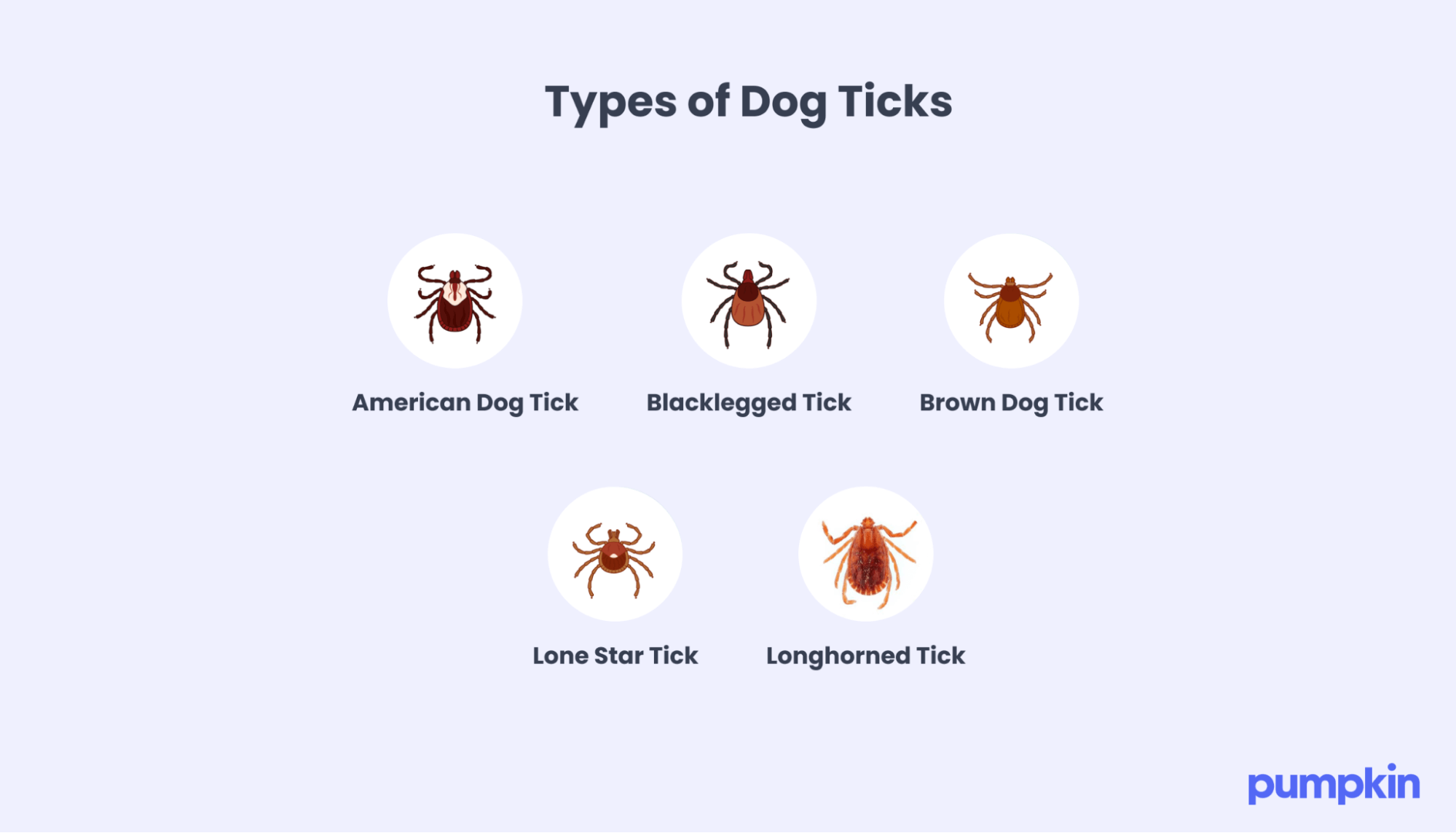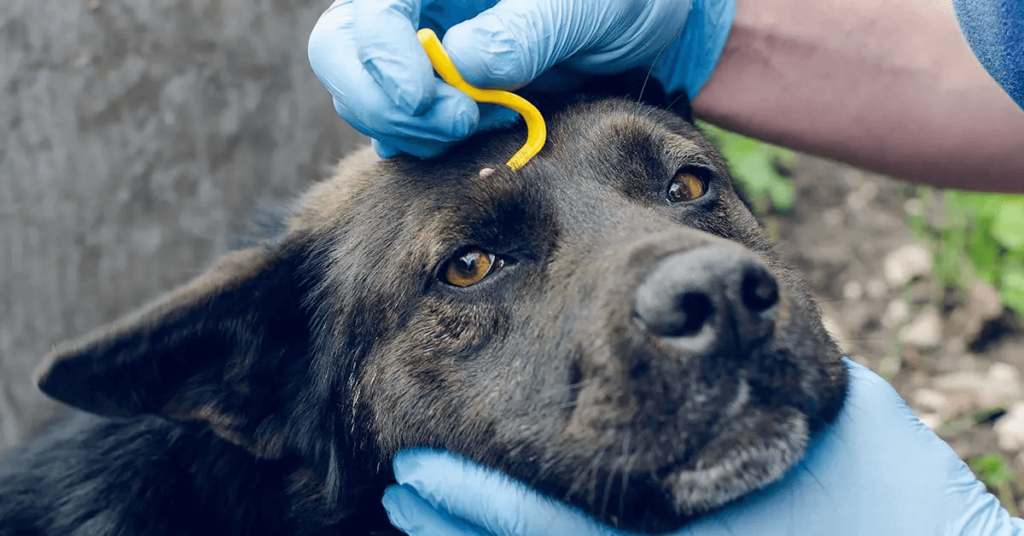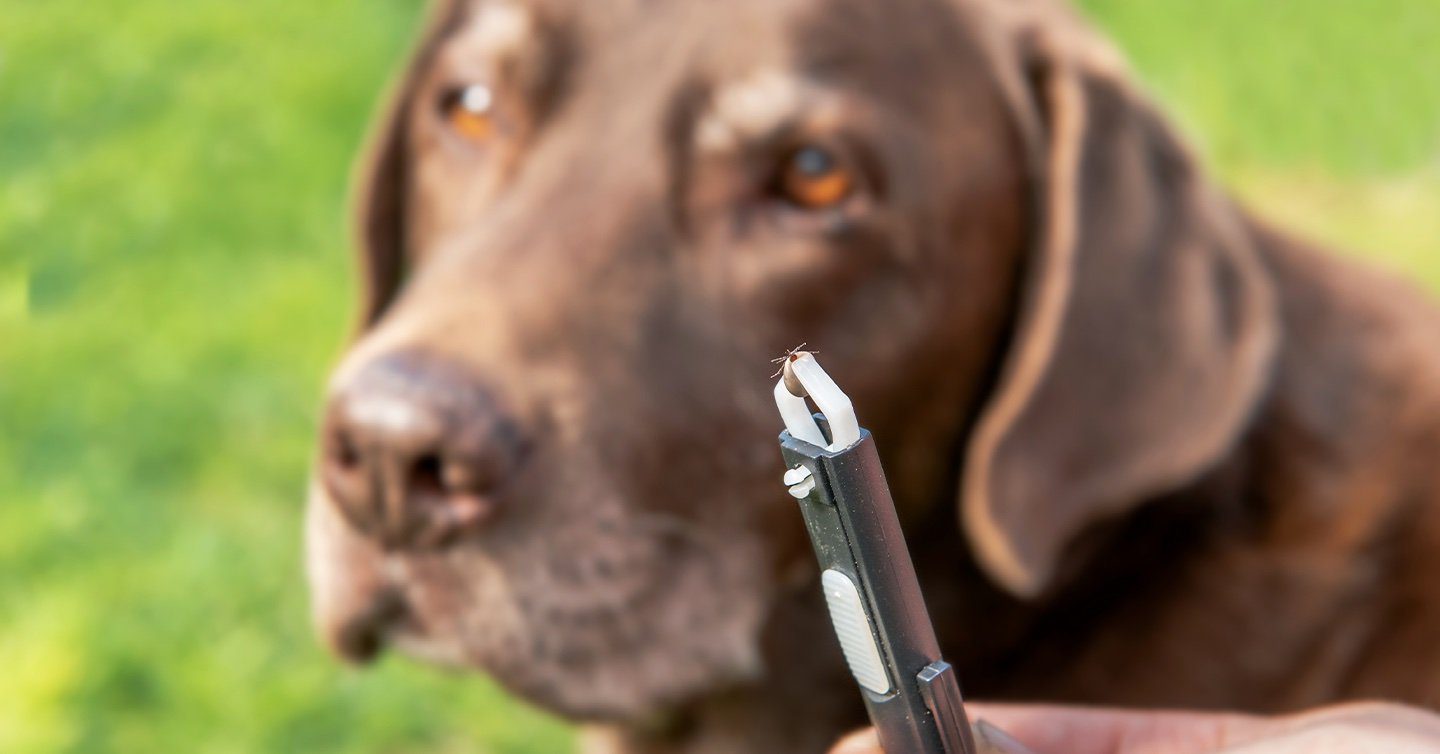Key Points
- There are mainly five types of ticks that feed on dogs: the American Dog Tick, Blacklegged Tick, Brown Dog Tick, Lone Star Tick, and Longhorned Tick.
- These ticks can be removed from your dog using a tweezer or a tick removal tool.
- Symptoms of common tick-borne diseases such as Lyme Disease include lethargy, fever, and swollen lymph nodes and joints.
Finding a tick on your dog inspires a primal feeling of revulsion in most people. Words like yuck, yikes, and kill it with fire! come to mind.
You may be wondering how to get a tick off your dog?
Don’t panic! Though finding a tick on your precious pooch can be scary at first, there are simple steps you can take to remove it safely and prevent future bites.
This guide breaks down what ticks are, how to prevent them, and how to safely get a tick off your dog. You want to act fast, so let’s get right to it.
What does a tick look like?
Ticks are foul little insects that can cause big trouble for our dogs.
They’re part of the arachnid family, like spiders, and have an oval body, eight legs, and tiny barbed mouthparts that attach to their host for feeding. Their crab-like legs emit a sticky substance, helping them stay attached to their host as their head burrows beneath the skin.
To find a host, these creepy creatures can sense carbon dioxide, movement, and warmth. Once they latch on, they inject a numbing agent to prevent pain and an anticoagulant to keep the blood flowing while they feed.
There are mainly five types of dog ticks:
- American Dog Tick
- Blacklegged Tick
- Brown Dog Tick
- Lone Star Tick
- Longhorned Tick

After a tick egg hatches, the tick becomes a tiny larva (a seed tick) that feeds on its host. The larva sheds its skin and grows into a larger nymph, and when it’s fed enough, it detaches to go in search of a new host.
How to get a tick off a dog: Step-by-step guide
You should wait until your dog is feeling calm to remove a tick, so wait for their post-walk zoomies to end before starting this process. You need to take care to remove all of the tick’s mouth parts embedded in your pup’s skin. That’s why you can’t simply pluck up a tick as soon as you spot one.
If your dog is restless, you can calm them down by giving them a chew toy, a lick mat covered in peanut butter, or some tasty dog treats.
Tools you’ll need to remove the tick:
- Gloves
- A pair of tweezers or a tick-removal tool
- Light or magnifying glass
- Disinfectant, antiseptic cream, or wound care ointment
- Isopropyl alcohol to kill the tick (optional)
1. Check the full body for ticks
If your dog spends a lot of time outside in tick-infested areas, especially if they travel through tall grass or thick brush, you should periodically perform tick inspections. Run your hands slowly over your dog’s body, looking for bumps, swelling, or any areas you see your dog biting or chewing (tick bites can be itchy).
Check everywhere — ticks aren’t picky about where they embed. Some places they like to hide include:
- The torso
- Between toes
- On the legs
- The space where the legs meet the torso
- Inside and around the ears
- On your dog’s face, including their eyelids and chin
- On the tail
- On the neck (even under the collar)
Then, if you notice a bump or swollen area, use a light or magnifying glass to look for a tick. You’ll see the legs and body protruding from your dog’s skin. As the tick feeds, the body swells up and eventually resembles a small bean.

Also, keep in mind that ticks can transfer between hosts. So, you’ll also need to check your family members and other pets.
2. Remove the tick
Once you find the tick, use tweezers or a tick removal tool (our preferred tool) to remove it. Here’s how to do it with each tool:
Tweezers
Never use blunt-ended tweezers. They can squeeze or crush the tick, releasing pathogens into your dog’s bloodstream. Plus, you also risk getting those pathogens onto yourself. Therefore, try to use tweezers with fine tips.
- Grasp the tick’s body close to your dog’s skin, being careful not to pinch them.
- Use a slow, steady motion to disengage it. Be sure not to jerk, twist, or pull since you don’t want to leave any mouthparts inside the wound (which can cause infection).
- The tick should loosen its mouthparts when it feels pressure, allowing you to gently remove it intact.
If you see any remaining tick parts in the bite wound, it’s best to keep an eye on your dog as their body naturally expels it. Otherwise, you can let your vet remove it.
Tick removal tool
This is the preferred method of tick removal since there’s less chance of crushing the tick, making the process much easier. If you live in an area where ticks are prevalent, you may want to look into a highly-rated tool like Tick Check and the Tick Stick.
- Place the tool against your dog’s skin near the tick and slide the notch (the V part of the tool) under the tick.
- Once you have the tick in the notch, carefully twist it with a steady upward motion. The tick should disengage, allowing you to remove it from the skin.
3. Kill the tick
Once you’ve examined the tick to ensure all its parts are intact, place it into the container with isopropyl alcohol to kill it.
Place the lid on top until you’re sure it’s dead. If you would like to have the tick tested or identified, you can save it to show your vet at your next appointment. Or, if you can’t stand the sight of the tick, you can also take a photo and flush the tick down the toilet.
Remember: ticks have very tough, squish-proof exoskeletons, which is why isopropyl alcohol is the best remedy.
4. Clean the wound
After you remove the tick from your dog’s skin, clean the bite area with an antiseptic and apply wound care ointment or lotion, such as medical-grade honey ointment.
Ineffective tick removal methods to avoid
You may have heard of other ways to remove a tick, such as burning it, drowning it with nail polish remover, or smothering it with Vaseline. While some of these methods may work, they’re not recommended since different ticks respond differently to specific methods.
For example, since American Dog Ticks have shorter mouthparts, burning them may work as they’ll release easier.
However, the same cannot be said for Blacklegged and Lone Star Ticks, which have longer mouthparts and attach with great tenacity. So, you’ll likely end up leaving some of their mouthparts behind (which release pathogens and result in tick-borne diseases), or you could even accidentally burn your dog.
Testing staff from the University of Rhode Island have tried many different methods to remove ticks and maintain that removing them with pointy tweezers and tick removal tools works best.
What is a tick-borne disease?
Tick-borne diseases infect thousands of animals and humans each year.
Although most ticks don’t transmit disease, some do. There are 15 diseases ticks can carry and pass on to their host, though the most commonly reported is Lyme Disease.
Watch your dog’s behavior for the next few months. The pathogen transmission can occur 3-6 hours after the tick bite, but symptoms typically only occur much later.
Symptoms may vary based on the exact disease. However, here are some common signs of tick-borne diseases:
- Loss of appetite
- Fatigue
- Fever
- Swollen joints
- Arthritis
- Lameness
- Reluctance to move
- Swollen lymph nodes
- Neurological problems (seizures are uncommon but can happen)
If you notice these symptoms after a tick bite, your dog may be experiencing the effects of a tick-borne disease like Lyme disease, Rocky Mountain Spotted Fever, or Anaplasmosis.
These require veterinary care and may jeopardize your pet’s health, so, act fast.
With a Pumpkin Dog Insurance plan, 90% cash back on eligible vet bills is an option for everyone. Don’t wait to protect your pup — fetch a free quote today!
When and where are ticks commonly found?
Ticks are commonly the most active from March to mid-May and then again from mid-August to November. However, ticks can survive year-round in areas where the ground temperature is above 45 degrees.
If you’re unsure whether your area is an active tick habitat, the Companion Animal Parasite Council (CAPC) and U.S. Centers for Disease Control and Prevention have interactive maps to explore.
Dogs can pick up ticks if they spend much time outdoors in tall grass, wooded areas, at the beach, or where the humidity is high with year-round warm temperatures.

How to prevent your dog from getting ticks
Luckily, there are simple ways to prevent your pup from becoming the host of these vile little creatures. Here are a few common tick preventatives:
- Topical flea and tick treatments: These are topical applications absorbed through the skin.
- Tick collars: Good for dogs that can’t tolerate spot-on treatments.
- Oral medications: Your veterinarian will know if your dog is a suitable candidate for oral tick medications.
- Tick sprays: Apply sprays directly onto your dog’s coat prior to going outdoors or before a hike in the woods; these should be used in addition to other preventatives.
- Tick shampoos: Shampoos can help repel ticks and stop them from hitching a ride on your dog.
- House and lawn treatments: Keeping your grass mowed and bushes trimmed can make it harder for ticks to dwell in your yard.
Curious about natural tick remedies and treatments? We recommend talking to your veterinarian about the most effective and safe flea and tick prevention options.
Keep your pup tick-free, healthy & happy
If your dog gets a tick, remember that removing it is easy, so long as you use the right tools and exercise care. And if you aren’t ready to face a tick, it’s perfectly fine to call in the calvary (your veterinarian) to remove it from your dog’s skin.
Though ticks are a real concern, they shouldn’t stop you from enjoying outdoor adventures with your beloved tail-wagger. For even more peace of mind when adventuring together, consider pet insurance. A Pumpkin Dog Insurance plan can help protect your pup and wallet if unexpected accidents or illnesses arise.




